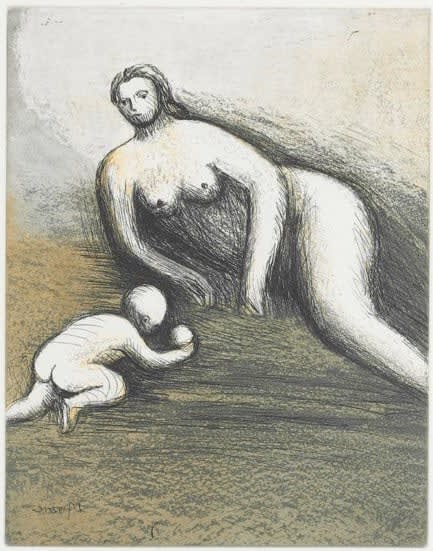Henry Moore U.K., 1898-1986
Mother and Child VI, 1983
Etching and aquatint in 4 colours on Arches paper
Signed by the artist, lower right on recto
Signed by the artist, lower right on recto
52.1 × 44 cm (framed: 56 x 48 cm)
© The Estate of Henry Moore
Henry Moore's exploration of the mother and child theme represents a profound artistic journey that transcends mere representation, embodying complex emotional and psychological landscapes. The artist repeatedly returned to this...
Henry Moore's exploration of the mother and child theme represents a profound artistic journey that transcends mere representation, embodying complex emotional and psychological landscapes. The artist repeatedly returned to this motif throughout his career, transforming it from tender, nurturing scenes to more provocative, psychologically charged compositions.
By 1983, when he created Mother and Child VI, Moore had already established himself as a pivotal figure in modern British sculpture. His work emerged from the crucible of two world wars, reflecting the vulnerability and resilience of human experience. The present work continues Moore's exploration of form, drawing inspiration from natural shapes and the human body.
Moore's artistic influence extends beyond individual works. He pioneered a distinctive sculptural language that bridged modernist abstraction and emotional depth. His sculptures and prints became powerful symbols of post-war reconstruction, representing hope and human connection while simultaneously acknowledging the era's profound trauma.
'Mother and Child VI' was created during the artist's mature period and reflects his lifelong fascination with the complex dynamics between maternal protection and potential conflict, a theme he explored throughout his artistic career.
Moore's legacy lies in his ability to create simultaneously universal and intimately personal art, making him a defining figure in 20th-century British modernism.
By 1983, when he created Mother and Child VI, Moore had already established himself as a pivotal figure in modern British sculpture. His work emerged from the crucible of two world wars, reflecting the vulnerability and resilience of human experience. The present work continues Moore's exploration of form, drawing inspiration from natural shapes and the human body.
Moore's artistic influence extends beyond individual works. He pioneered a distinctive sculptural language that bridged modernist abstraction and emotional depth. His sculptures and prints became powerful symbols of post-war reconstruction, representing hope and human connection while simultaneously acknowledging the era's profound trauma.
'Mother and Child VI' was created during the artist's mature period and reflects his lifelong fascination with the complex dynamics between maternal protection and potential conflict, a theme he explored throughout his artistic career.
Moore's legacy lies in his ability to create simultaneously universal and intimately personal art, making him a defining figure in 20th-century British modernism.
Provenance
Catalogue Number: CGM 676Publications
1) Henry Moore: Catalogue of Graphic Work, Volume 4, 1980-1984; by Patrick CRAMER, Alistair GRANT, David MITCHINSON.2) Henry Moore: Prints and Portfolios



